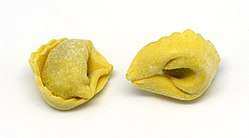Tortellini
 The distinctive shape of tortellini | |
| Alternative names | Belly button |
|---|---|
| Type | Pasta, Dumplings |
| Place of origin | Italy |
| Region or state | Emilia-Romagna |
| Variations | Tortelloni |
Tortellini are ring-shaped pasta, sometimes also described as "navel shaped", hence their alternative name of "belly button" (ombelico).[1] They are typically stuffed with a mix of meat (pork loin, prosciutto), cheese, or a combination of both. Originally from the Italian region of Emilia (in particular Bologna and Modena), they are usually served in broth (in brodo), either of beef, chicken, or both.[2]
Packed, refrigerated or frozen, tortellini and tortelloni (similar but larger, with cheese and/or vegetable stuffing) appear in many locations around the world, especially where there are large Italian communities. Tortellini and tortelloni are made in European industrial lines supplying markets in Europe and further afield. "Fresh" packed tortellini usually have 7 weeks of shelf-life.
Origins
The origin of tortellini is disputed; both Bologna and Modena, cities in Italy's Emilia-Romagna region, claim to be its birthplace.[3] OxfordDictionaries.com traces the etymology of tortellini to the diminutive form of tortello, itself a diminutive of torta. Both reference cake.[4] The recipe for a dish called torteletti appears in 1570 from Bartolomeo Scappi. Vincenzo Tanara's writings in the mid-17th century may be responsible for the pasta's renaming to tortellini. In the 1800s, legends sprang up to explain the recipe's origins, offering a compromise. Castelfranco Emilia, located between Bologna and Modena,[3] is featured in one legend, in which Venus stays at an inn. Overcome by her beauty, the innkeeper spies on her through a keyhole, through which he can only see her navel. He is inspired to create a pasta in this shape. In honor of this legend, an annual festival is held in Castelfranco Emilia.[5] Another legend posits that the shape comes from Modena's architecture, which resembles a turtle.[6]

Comparison to tortelloni
Tortelloni is pasta in the same shape, but larger, typically 5 g, vs. 2 g for tortellini.[7] Although either can be filled with a wide variety of foods, meat-based filling is less common in tortelloni. Tortellini may be served with sauce or in a broth; tortelloni are rarely served in a broth.
Nutrition data
Tortellini pasta, with cheese filling, fresh-refrigerated, as purchased
| Nutrient | Unit | 1 Value per 100 g | Amount per 0.75 cup (81 g) |
|---|---|---|---|
| Calories | 307 | 249 | |
| Proximates | |||
| Water | g | 30.50 | 24.70 |
| Protein | g | 13.50 | 10.94 |
| Total lipid (fat) | g | 7.23 | 5.86 |
| Carbohydrate, by difference | g | 47.00 | 38.07 |
| Fiber, total dietary | g | 1.9 | 1.5 |
| Sugars, total | g | 0.95 | 0.77 |
– Source:[8]
See also
References
- ↑ The Oxford Companion to Italian Food by Gillian Riley
- ↑ Official "Order of the Tortellino" Recipe for Tortellini
- 1 2 Zanini De Vita, Oretta (2009). Encyclopedia of Pasta. University of California Press. pp. 297–299. ISBN 9780520944718.
- ↑ "The meaning of pasta names". OxfordDictionaries.com. Retrieved 12 May 2018.
- ↑ Poggioli, Sylvia (27 August 2013). "Tortellini, The Dumpling Inspired By Venus' Navel". NPR. Retrieved 12 May 2018.
- ↑ Marsden, Shelley (4 December 2015). "The secret to tortellini, Modena's special pasta". The Daily Telegraph. Retrieved 12 May 2018.
- ↑ Barilla US (manufacturer) FAQ
- ↑ "Tortellini Nutrition data". USDA. USDA. Retrieved 30 September 2015.
External links
| Wikimedia Commons has media related to Tortellini. |